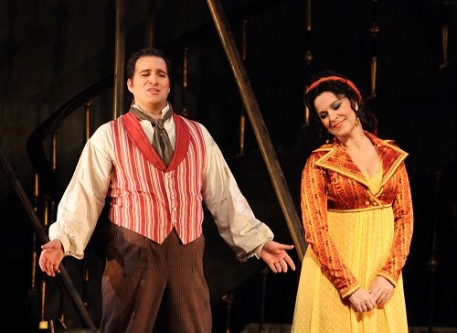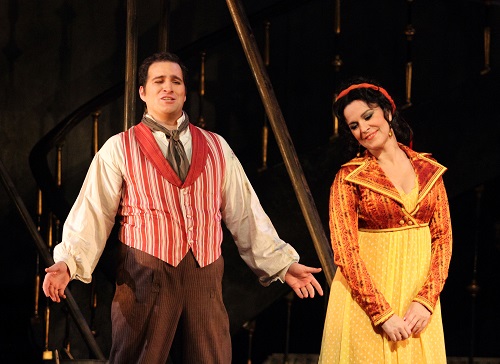 United Kingdom Puccini, Tosca: Soloists, Royal Opera House Chorus and Orchestra / Emmanuel Villaume (conductor). Royal Opera House, Covent Garden, London. 9.1.2016. (JPr)
United Kingdom Puccini, Tosca: Soloists, Royal Opera House Chorus and Orchestra / Emmanuel Villaume (conductor). Royal Opera House, Covent Garden, London. 9.1.2016. (JPr)

Production:
Director: Jonathan Kent
Revival Director: Andrew Sinclair
Designs: Paul Brown
Lighting design: Mark Henderson
Cast included:
Floria Tosca: Angela Gheorghiu
Mario Cavaradossi: Riccardo Massi
Baron Scarpia: Samuel Youn
Angelotti: Yuriy Yurchuk
Spoletta: Hubert Francis
Sacristan: Donald Maxwell
Sciarrone: David Shipley
Gaoler: John Morrissey
Perhaps since this was my first opera performance of 2016 after an extended musical break for Christmas and my critical faculties – for what they are worth – being somewhat refreshed, it found me enjoying this seventh revival of Jonathan Kent’s 2006 Tosca production enormously … and more than I possibly expected. A phrase you occasionally hear is ‘This is not my first rodeo’ and certainly this was the umpteenth time I had seen Puccini’s ‘shabby little shocker’ as Joseph Kerman dismissed it. I have suggested before how a great performance of Tosca is a visceral experience and should take you on an emotional rollercoaster ride that makes you realise how Puccini never wasted a note. Since my eyes moistened during ‘Vissi d’arte’ – sung with the utmost autobiographical fervour by Angela Gheorghiu – this must have been a stronger revival than some.
There was a heightened sense of drama throughout and palpable tension from two vastly experienced principals as Floria Tosca and her lover, Mario Cavaradossi, who have sung their roles throughout the world and although Samuel Youn as Scarpia was making his house debut he is a very accomplished singer. Tosca does not always need the greatest conductor to bring it off successfully but a less-than-good one can spoil things, however, Emmanuel Villaume – music director of Dallas Opera – knew what to do and his conducting here was mostly passionate and sweeping, and occasionally cranked up the tension almost unbearably such as during the torture scene and Scarpia’s death in Act II. He grabbed this listener’s attention from the opening chords and kept it throughout until the closing ones … and as a result the evening flew by.
As years pass the story of an operatic diva, her political free-thinker painter lover, a sadistic chief-of-police all caught in a net of love and revolution seems a very modern one. Throw in a couple of suicides, an attempted rape, the torture scene and how much Scarpia relishes it, the horrendous choice Tosca faces and her expressed disgust and hatred of him, a murder and a death by firing squad; and it all has an almost Tarantino-like twenty-first century violence that guarantees box-office success now – but was a surprising choice of subject for Puccini in 1900. It made me appreciate Antonio Pappano and Kasper Holten’s ‘Welcome’ in the programme which concluded with the words ‘Whether you are coming for the first time or know Tosca inside out, we hope it will feel fresh to you, and this thrilling opera will keep you in suspense. If you already know how it ends, try to forget and let yourself be swept away by Puccini’s marvellous music.’ I did … and I was!
I get the impression Jonathan Kent’s production has been somewhat vilified because it isn’t Franco Zeffirelli’s much-revered 1964 one – remembered from the filmed performance with Maria Callas and Tito Gobbi – which it replaced. Paul Brown’s sets are traditional, detailed and three-dimensional, his costumes also seem to fit the period and it all provides everything needed for Tosca. There are the three major locations from the Rome of Napoleonic times; the church of Sant’Andrea della Valle with its double staircase, Scarpia’s Palazzo Farnese apartment lined with empty bookshelves and the desolate moonlit scene for the execution at the Castel Sant’Angelo. Mark Henderson’s lighting remains rather dingy at times but it all has a welcome – almost cinematic – atmosphere throughout. Everything combines to allow the well-known tale to unfold unhindered by directorial whim. My only possible criticism of the production is that everything is mostly restricted to just the front third of the stage or thereabouts.
Angela Gheorghiu is not a regular visitor these days to Covent Garden but her performance was a constant reminder of the difference between the endangered species of great artists – which she is undoubtedly one – as compared with reasonably accomplished singers of which there is an almost never ending assembly line. Admittedly she does seem overly preoccupied with arranging her dress at some of her most intense moments but back once again as Tosca (which she created for this production in 2006) her voice was resplendent and her tone still full, mellow and smooth. She was irresistible in Act I as the playful Tosca flirting and teasing her recent conquest. As all the unfolding politics, torture and the threat of sexual violence impinged on her character, Ms Gheorghiu’s voice showed tremendous power and the necessary searing intensity. Her exclamations of horror and outrage at the opera’s denouement were thrillingly delivered.
I cannot remember seeing Samuel Youn outside Bayreuth and this therefore was my first time hearing him sing anything other than Wagner. He is not a physically imposing Scarpia as Bryn Terfel was – and few indeed could be – but he had a sort of pugnacious look to him and imbued him with a sense of quiet menace. Youn’s oleaginous courtship of the diva in Act I allowed the smoothly baritonal part of his voice to be appropriately seductive. As the evening went on – and he needed to be more aggressive and brutal – his dark, stentorian bass-baritone voice grew a little coarser until it was truly threatening especially during the extended confrontation in Act II.
Riccardo Massi returned to this production as painter/patriot Cavaradossi. I know for ‘Recondita armonia’ Puccini has not given a tenor much chance to warm up but on this occasion it was rather tentative as if he was trying to sing his way through a cold. It was not bad but not the statement of vocal intent it must be. The darkness in his voice reminded me of Jonas Kaufmann but unlike that famous German singer, Massi’s sound has a genuine Italianate squillo. As when I heard him before his Act II cries of ‘Vittoria! Vittoria!’ might have reached from Rome to Napoleon’s Paris mausoleum. Cavaradossi can be a bit of a cypher but Massi is a believable actor and never more so than in Act III which I have never seen better than the way he does it. After a moving rendition of the brief but passionate ‘E lucevan le stelle’ he very affectingly shows how Cavaradossi knows he will die yet goes along with his beloved, deluded, Tosca who herself believes they will soon be free to begin their life together.
The Royal Opera Orchestra and Chorus were excellent as always but there are ten performances in this run with significant changes of principals and conductor. However, there is most consistency in the smaller parts which have been strongly cast: Yuriy Yurchuk – a Jette Parker Young Artist – as the anxious and desperately fleeing Angelotti, the genial, huffing and puffing, food and drink-loving Sacristan of Donald Maxwell and the ruthlessly efficient, servile, Spoletta of Hubert Francis, all added significantly to the tension-filled realism of this Tosca.
Thinking about that ‘Welcome’ in the programme the evening had indeed seemed to have drawn a number of ‘first-timers’ to this Tosca … and if this was also their first opera at the Royal Opera House, they could have chosen many worse nights to be there and they will be left with wonderful recollections of this one. I have written before how near the end Tosca and Cavaradossi sing of their future happiness as ‘a harmony of colour and song’: we know that will never be but this once again appropriately sums up my reaction to another memorable Tosca.
Jim Pritchard
